Instructor Planning Guide
Activities
What activities are associated with this chapter?
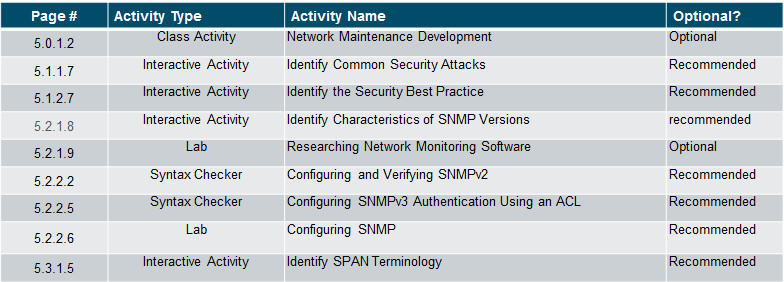

Assessment
Students should complete Chapter 5, “Assessment” after completing Chapter 5.
Quizzes, labs, Packet Tracers and other activities can be used to informally assess student progress.
Sections & Objectives
5.1 LAN Security
Explain how to mitigate common LAN security attacks.
Describe common LAN security attacks.
Explain how to use security best practices to mitigate LAN attacks.
5.2 SNMP
Configure SNMP to monitor network operations in a small to medium-sized business network.
Explain how SNMP operates.
Configure SNMP to compile network performance data.
5.3 Cisco Switch Port Analyzer (SPAN)
Troubleshoot a network problem using SPAN.
Explain the features and characteristics of SPAN.
Configure local SPAN.
Troubleshoot suspicious LAN traffic using SPAN.
Chapter 5: Network Security and Monitoring
5.1 – LAN Security
5.1.1 – LAN Security Attacks
5.1.1.1 – Common LAN Attacks
Common security solutions using routers, firewalls, Intrusion Prevention System (IPSs), and VPN devices protect Layer 3 up through Layer 7.
Layer 2 must also be protected.
Common Layer 2 attacks include:
- CDP Reconnaissance Attack
- Telnet Attacks
- MAC Address Table Flooding Attack
- VLAN Attacks
- DHCP Attacks
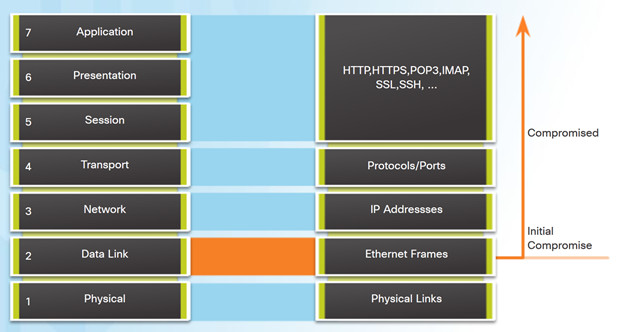
5.1.1.2 – CDP Reconnaissance Attack
The Cisco Discovery Protocol (CDP) is a proprietary Layer 2 link discovery protocol, enabled by default.
CDP can automatically discover other CDP-enabled devices.
CDP information can be used by an attacker.
Use the no cdp run global configuration command to disable CDP globally.
Use the no cdp enable interface configuration command to disable CDP on a port.
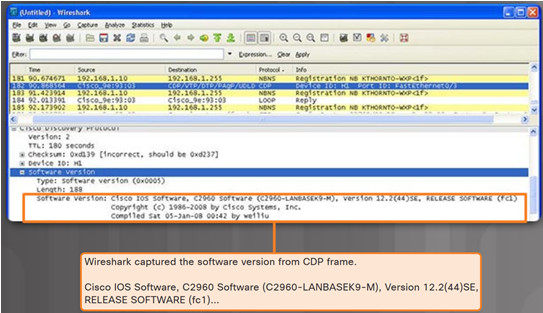
5.1.1.3 – Telnet Attacks
There are two types of Telnet attacks:
- Brute Force Password Attack – trial-and-error method used to obtain the administrative password.
- Telnet DoS Attack – Attacker continuously requests Telnet connections in an attempt to render the Telnet service unavailable.
To mitigate these attacks:
- Use SSH
- Use strong passwords that are changed frequently.
- Limit access to the vty lines using an access control list (ACL)
- Use AAA with either TACACS+ or RADIUS protocols.
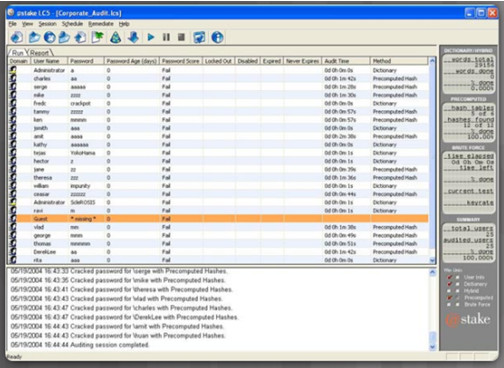
5.1.1.4 – MAC Address Table Flooding Attack
Common LAN switch attack is the MAC address table flooding attack.
- An attacker sends fake source MAC addresses until the switch MAC address table is full and the switch is overwhelmed.
- Switch is then in fail-open mode and broadcasts all frames, allowing the attacker to capture those frames.
Configure port security to mitigate these attacks.
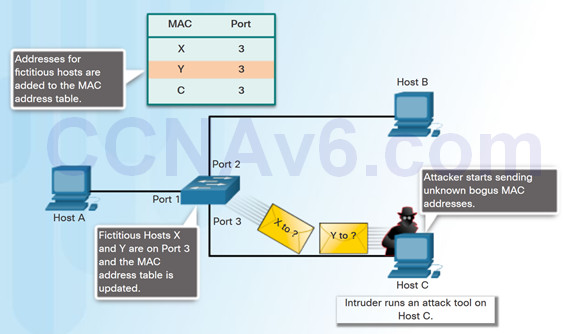
5.1.1.5 – VLAN Attacks
Switch spoofing attack – an example of a VLAN attack.
- Attacker can gain VLAN access by configuring a host to spoof a switch and use the 802.1Q trunking protocol and DTP to trunk with the connecting switch.
Methods to mitigate VLAN attacks:
- Explicitly configure access links.
- Disable auto trunking.
- Manually enable trunk links.
- Disable unused ports, make them access ports, and assign to a black hole VLAN.
- Change the default native VLAN.
- Implement port security.
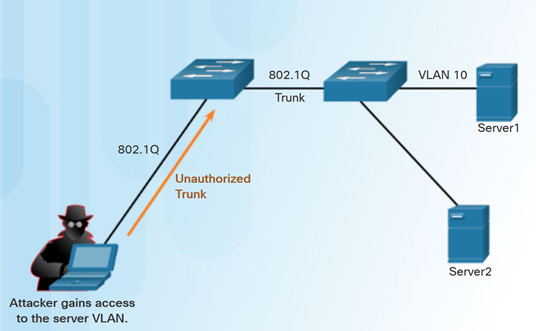
5.1.1.6 – DHCP Attacks
DHCP spoofing attack – An attacker configures a fake DHCP server on the network to issue IP addresses to clients.
DHCP starvation attack – An attacker floods the DHCP server with bogus DHCP requests and leases all of the available IP addresses. This results in a denial-of-service (DoS) attack as new clients cannot obtain an IP address.
Methods to mitigate DHCP attacks:
- Configure DHCP snooping
- Configure port security
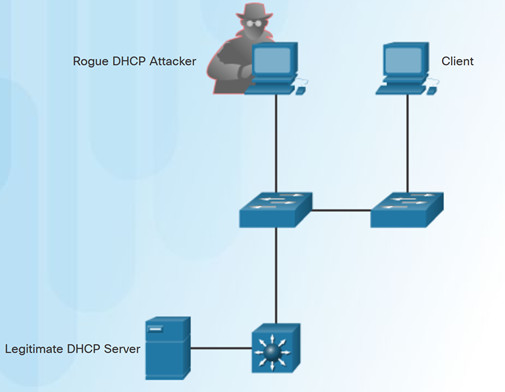
5.1.2 – LAN Security Best Practices
5.1.2.1 – Secure the LAN
Strategies to help secure Layer 2 of a network:
- Always use secure variants of protocols such as SSH, SCP, and SSL.
- Use strong passwords and change often.
- Enable CDP on select ports only.
- Secure Telnet access.
- Use a dedicated management VLAN
- Use ACLs to filter unwanted access.
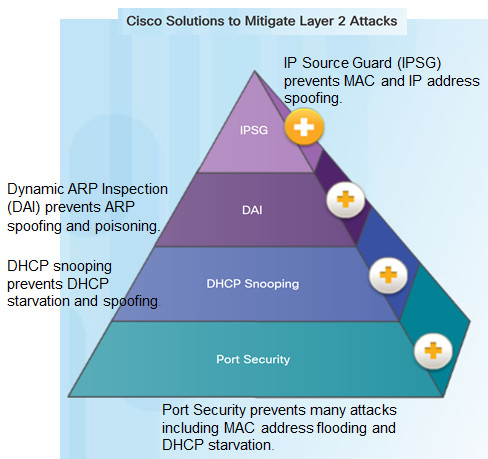
5.1.2.2 – Mitigate MAC Address Flooding Table Attacks
Enable port security to prevent MAC table flooding attacks.
Port security allows an administrator to do the following:
- statically specify MAC addresses for a port.
- permit the switch to dynamically learn a limited number of MAC addresses.
- when the maximum number of MAC addresses is reached, any additional attempts to connect by unknown MAC addresses will generate a security violation.
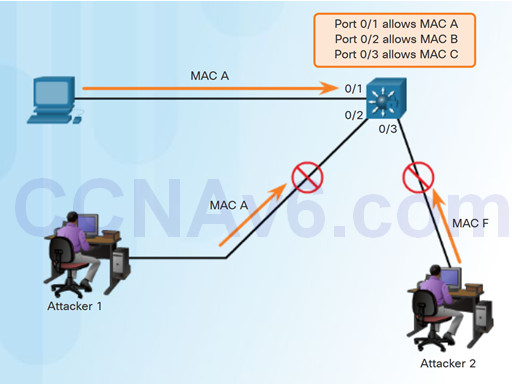
5.1.2.3 – Mitigate VLAN Attacks
To prevent basic VLAN attacks:
- Disable DTP (auto trunking) negotiations on non-trunk ports and use switchport mode access.
- Manually enable trunk links using switchport mode trunk.
- Disable DTP (auto trunking) negotiations on trunking and non-trunking ports using switchport nonegotiate.
- Change the native VLAN from VLAN 1.
- Disable unused ports and assign them to an unused VLAN.
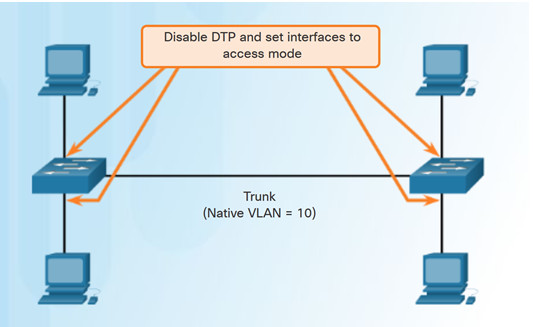
5.1.2.4 – Mitigate DHCP Attacks
To prevent DHCP attacks use DHCP snooping.
With DHCP snooping enabled on an interface, the switch will deny packets containing:
- Unauthorized DHCP server messages coming from an untrusted port.
- Unauthorized DHCP client messages not adhering to the DHCP Snooping Binding Database or rate limits.
DHCP snooping recognizes two types of ports:
- Trusted DHCP ports – Only ports connecting to upstream DHCP servers should be trusted.
- Untrusted ports – These ports connect to hosts that should not be providing DHCP server messages.
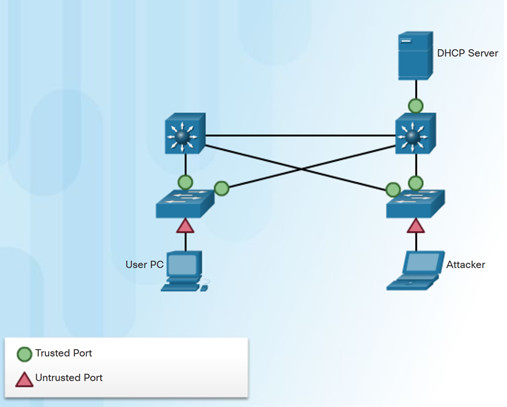
5.1.2.5 – Secure Administrative Access using AAA
Local AAA Authentication
- Client establishes a connection with the router.
- AAA router prompts the user for username and password.
- Router authenticates the username and password using the local database, and allows user access

Server-Based AAA Authentication
- Client establishes a connection with the router.
- AAA router prompts the user for a username and password.
- The router authenticates the username and password using a remote AAA server.
The AAA router uses Terminal Access Controller Access Control System (TACACS+) or Remote Authentication Dial-In User Service (RADIUS) protocol to communicate with the AAA server.

5.1.2.6 – Secure Device Access using 802.1X
IEEE 802.1X standard defines a port-based access control and authentication protocol.
- Restricts unauthorized workstations from connecting to a LAN.
- The authentication server authenticates each workstation connected to a switch port before making any services available.

5.2 – SNMP
5.2.1 – SNMP Operation
5.2.1.1 – Introduction to SNMP
Simple Network Management Protocol (SNMP) enables network administrators to monitor and manage network nodes.
The SNMP system consists of three elements:
- SNMP manager- collects information from an SNMP agent using the “get” action. Changes configurations on an agent using the “set” action.
- SNMP agents (managed node)
- Management Information Base (MIB)- stores data and operational statistics about the managed device.
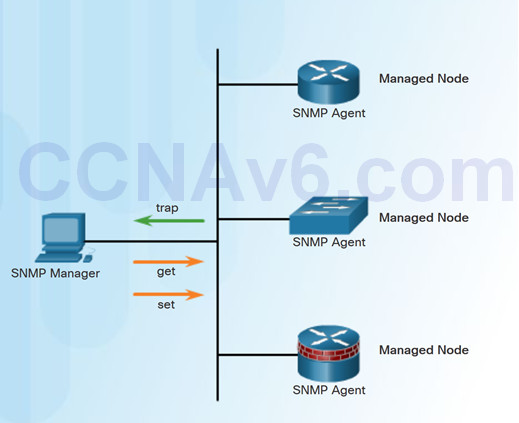
5.2.1.2 – SNMP Operation
SNMP agents that reside on managed devices collect and store information about the device.
This information is stored by the agent locally in the MIB.
SNMP manager then uses the SNMP agent to access information within the MIB.
SNMP agent responds to SNMP manager requests as follows:
- Get an MIB variable – The SNMP agent performs this n response to a GetRequest-PDU from the network manager.
- Set an MIB variable – The SNMP agent performs this in response to a SetRequest-PDU from the network manager.
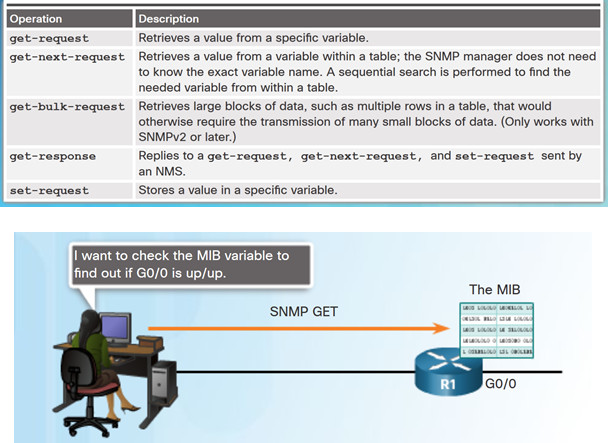
5.2.1.3 – SNMP Agent Traps
An Network Management System (NMS) periodically polls the SNMP agents using the get request.
Using this process, SNMP can collect information to monitor traffic loads and to verify device configurations of managed devices.
SNMP agents to generate and send traps to inform the NMS immediately of certain events.
Traps are unsolicited messages alerting the SNMP manager to a condition or event such as improper user authentication or link status.
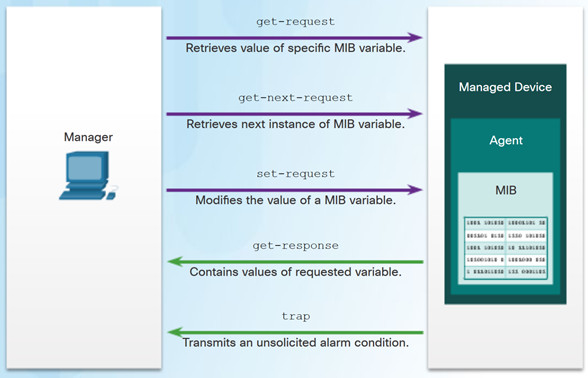
5.2.1.4 – SNMP Versions
All versions use SNMP managers, agents, and MIBs, this course focuses on versions 2c and 3.
A network administrator must configure the SNMP agent to use the SNMP version supported by the management station.
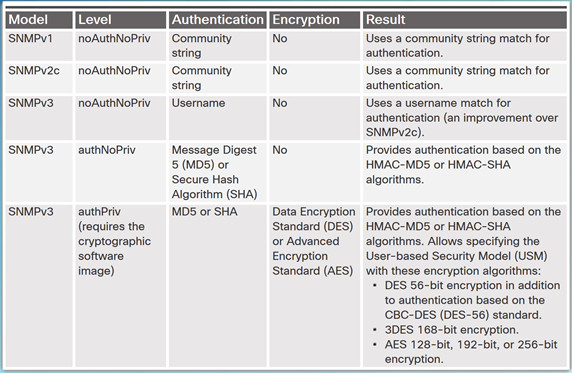
5.2.1.5 – Community Strings
SNMPv1 and SNMPv2c use community strings that control access to the MIB.
Two types of community strings:
- Read-only (ro) – Provides access to the MIB variables, but no changes can be made.
- Read-write (rw) – Provides read and write access to all objects in the MIB.
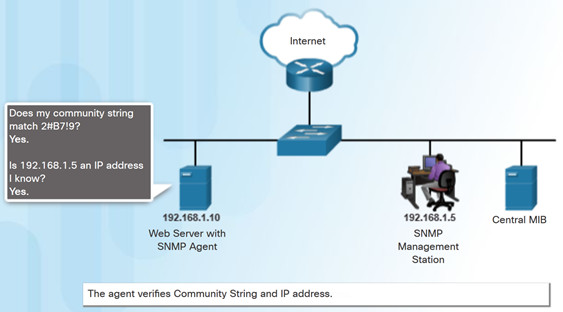
5.2.1.6 – Management Information Base Object ID
The MIB defines each variable as an object ID (OID).
- OIDs uniquely identify managed objects.
- OIDs are organized based on RFC standards into a hierarchy or tree.
Most devices implement RFC defined common public variables.
- Vendors such as Cisco can define private branches on the tree to accommodate their own variables.
CPU is one of the key resources, it should be measured continuously.
- An SNMP graphing tool can periodically poll SNMP agents, and graph the values.
- The data is retrieved via the snmpget utility.
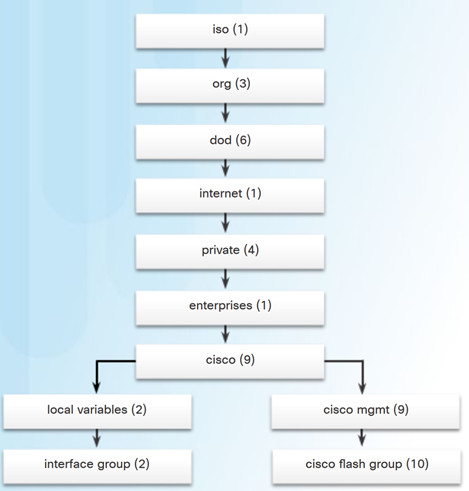
5.2.1.7 – SNMPv3
SNMPv3 authenticates and encrypts packets over the network to provide secure access to devices.
SNMPv3 provides three security features:
- Message integrity and authentication – Transmissions from the SNMP manager to agents (managed nodes) can be authenticated.
- Encryption – SNMPv3 messages may be encrypted to ensure privacy.
- Access control – Restricts SNMP managers to certain actions on specific portions of data.
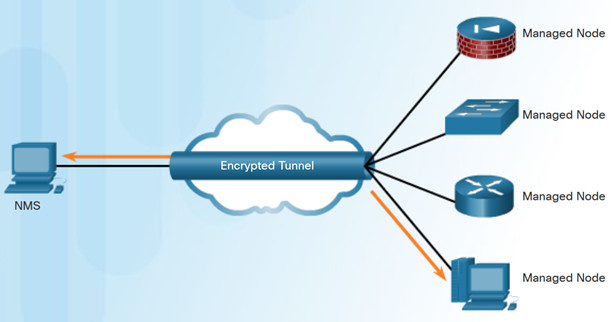
5.2.1.9 – Lab – Researching Network Monitoring Software
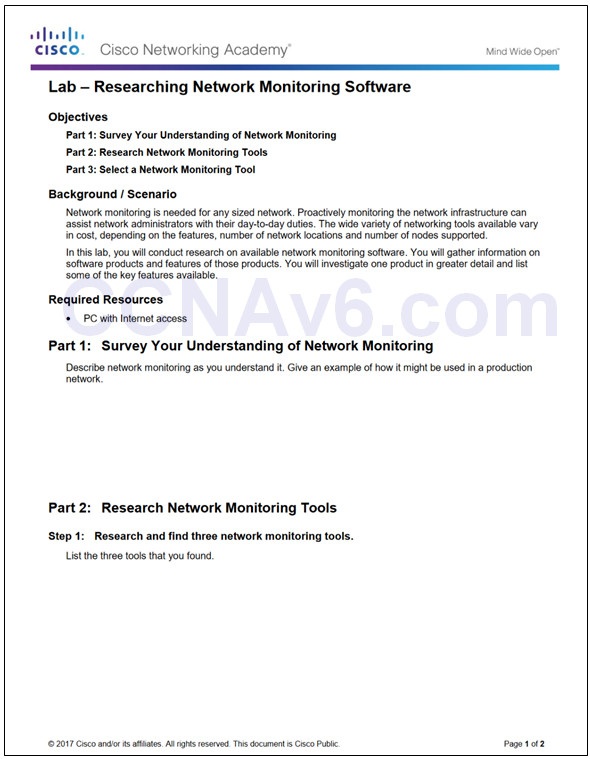
5.2.1.9 Lab – Researching Network Monitoring Software
5.2.2 – Configuring SNMP
5.2.2.1 – Steps for Configuring SNMP
Basic steps to configuring SNMP:
1.Configure the community string and access level using snmp-server community string ro | rw command.
2.(Optional) Document the location of the device using the snmp-server location text command.
3.(Optional) Document the system contact using the snmp-server contact text command.
4.(Optional)Use an ACL to restrict SNMP access to NMS hosts (SNMP managers). Reference the ACL using snmp-server community string access-list-number-or-name.
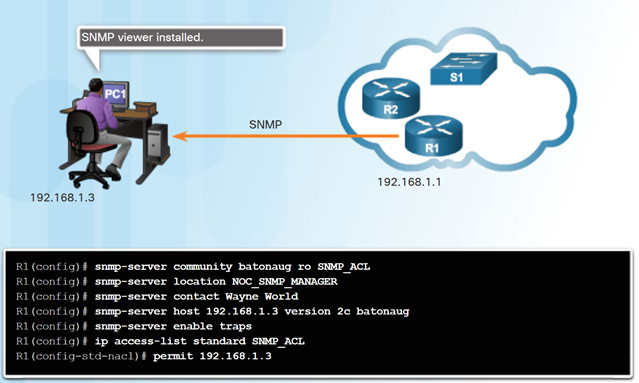
5.2.2.2 – Verifying SNMP Configuration
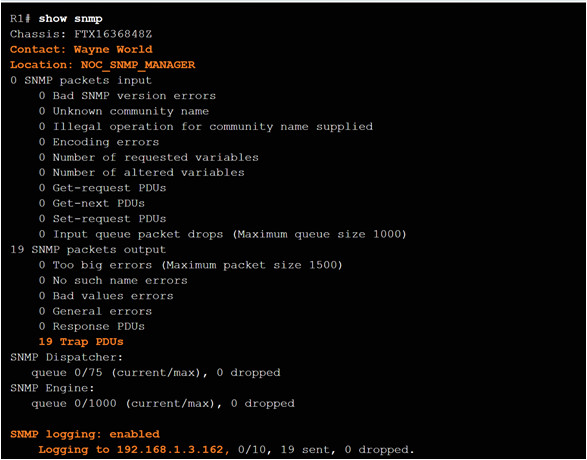
Kiwi Syslog Server is one of several solutions that display SNMP output.
The SNMP traps are sent to the SNMP manager and displayed on the syslog server.
To verify the SNMP configuration use the show snmp command.
Use the show snmp community command to show SNMP community string and ACL information.
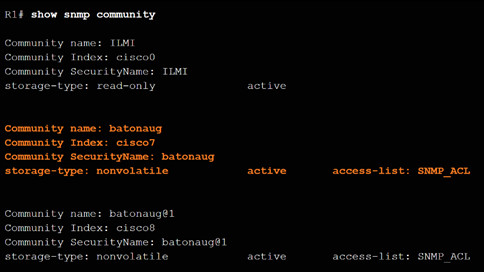
5.2.2.3 – SNMP Best Practices
SNMP can create security vulnerabilities.
For SNMPv1 and SNMPv2c – community strings should be strong and changed frequently.
ACLs should be used to prevent SNMP messages from going beyond the required devices and to limit access to monitored devices.
SNMPv3 is recommended because it provides security authentication and encryption.
- The snmp-server group groupname {v1 | v2c | v3 {auth | noauth | priv}} command creates a new SNMP group on the device.
- The snmp-server user username groupname command is used to add a new user to the group.
5.2.2.4 – Steps for Configuring SNMPv3
Steps to configure SNMPv3:
1.Configure a standard ACL that will permit access for authorized SNMP managers.
2.Configure an SNMP view to identify which OIDs the SNMB manager will be able to read.
3.Configure the SNMP group and features including name, version, type of authentication and encryption, associates view to the group, read or write, filter with ACL.
4.Configure a user with features including username, associates with group, version, authentication type, encryption type and password.
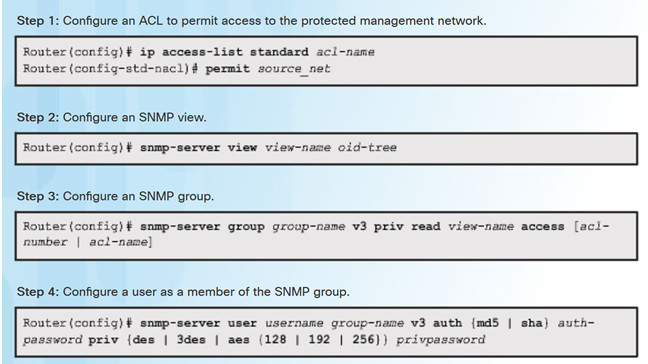
5.2.2.5 – SNMPv3 Configuration
The example configures a standard ACL named PERMIT-ADMIN. It is configured to permit only the 192.168.1.0/24 network. All hosts attached to this network will be allowed to access the SNMP agent running on R1.
An SNMP view is named SNMP-RO and is configured to include the entire ISO tree from the MIB.
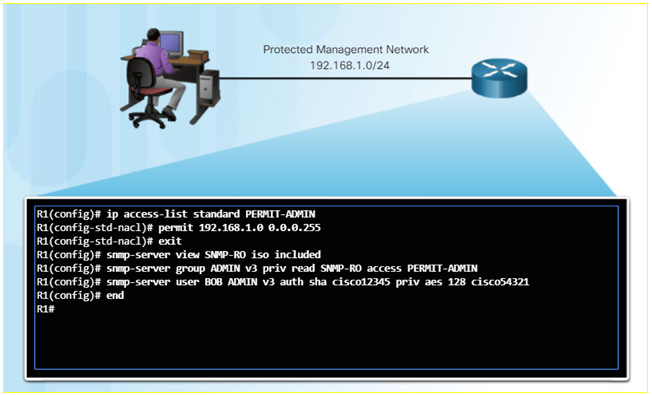
5.2.2.6 – Lab – Configuring SNMP
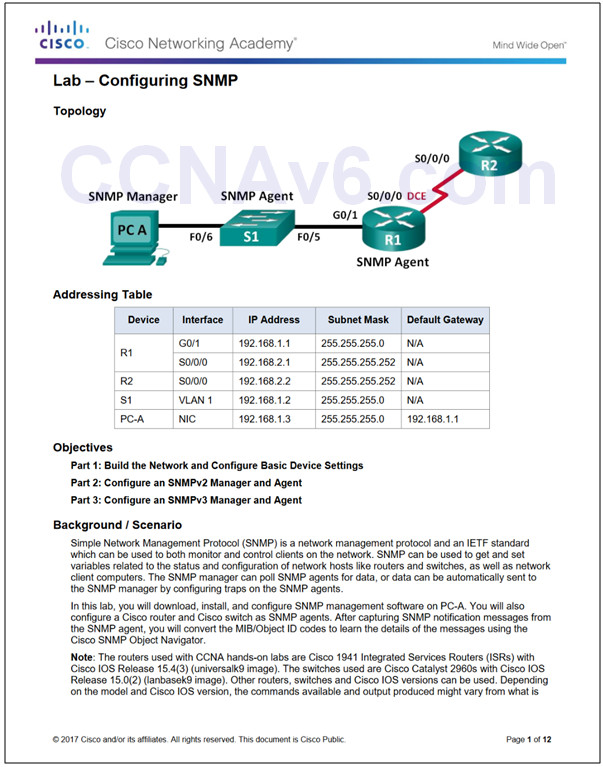
5.2.2.6 Lab – Configuring SNMP
5.3 – Cisco Switch Port Analyzer
5.3.1 – SPAN Overview
5.3.1.1 – Port Mirroring
Port mirroring allows a switch to copy and send Ethernet frames from specific ports to the destination port connected to a packet analyzer.
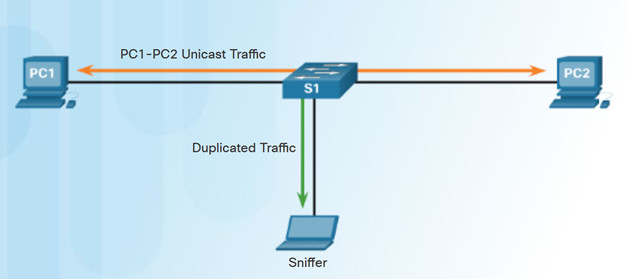
5.3.1.2 – Analyzing Suspicious Traffic
SPAN is a type of port mirroring that allows administrators or devices to collect and analyze traffic.
SPAN is commonly implemented to deliver traffic to specialized devices including:
- Packet analyzers – Using software such as Wireshark to capture and analyze traffic for troubleshooting purposes.
- Intrusion Prevention Systems (IPSs) –IPSs are focused on the security aspect of traffic and are implemented to detect network attacks as they happen.
SPAN can be implemented as either Local SPAN or Remote SPAN (RSPAN).
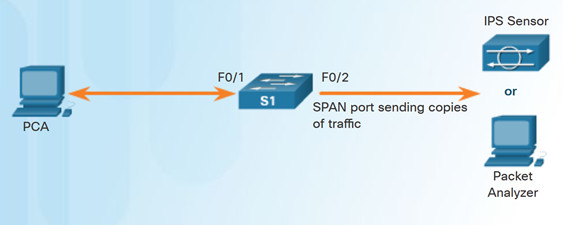
5.3.1.3 – Local SPAN
Local SPAN is when traffic on a switch is mirrored to another port on that switch.
A SPAN session is the association between source ports (or VLANs) and a destination port.
Three important things to consider when configuring SPAN:
- The destination port cannot be a source port, and the source port cannot be a destination port.
- The number of destination ports is platform-dependent.
- The destination port is no longer a normal switch port. Only monitored traffic passes through that port.
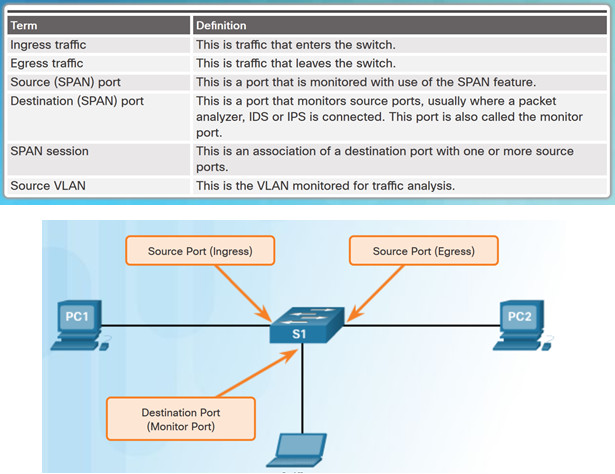
5.3.1.4 – Remote SPAN
Remote SPAN (RSPAN) allows source and destination ports to be in different switches.
RSPAN uses two sessions.
- One session is used as the source and one session is used to copy or receive the traffic from a VLAN.
- The traffic for each RSPAN session is carried over trunk links in a user-specified RSPAN VLAN
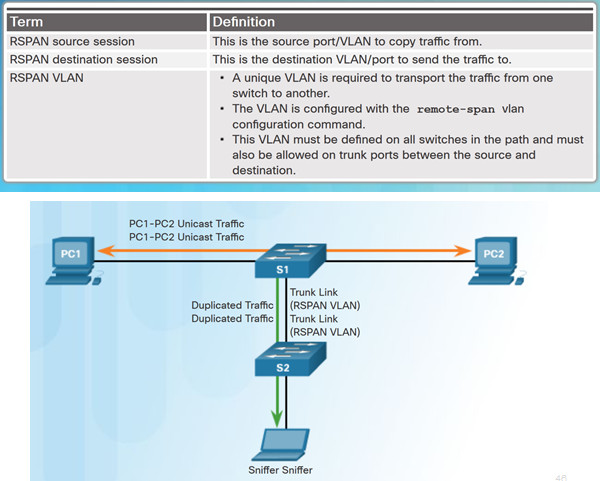
5.3.2 – SPAN Configuration
5.3.2.1 – Configuring Local SPAN
A session number is used to identify a local SPAN session.
Use monitor session command to associate a source port and a destination port with a SPAN session.
A separate monitor session command is used for each session.
A VLAN can be specified instead of a physical port.
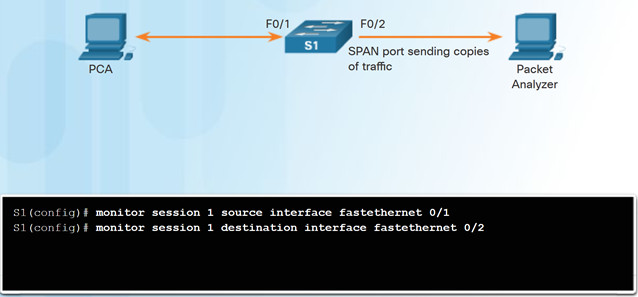
5.3.2.2 – Verifying Local SPAN
Use the show monitor command to verify the SPAN session. It displays the type of the session, the source ports for each traffic direction, and the destination port.
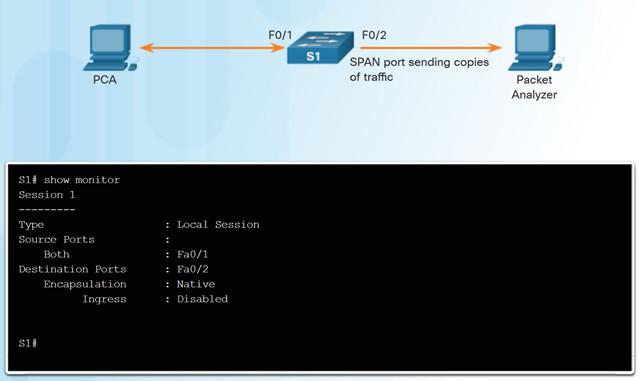
5.3.2.3 – Lab – Implement a Local SPAN
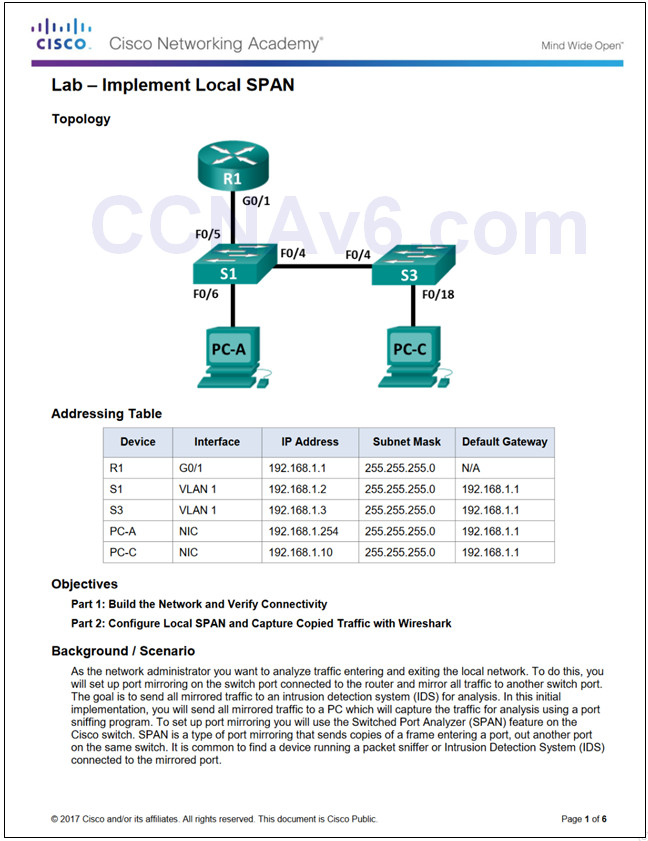
5.3.2.3 Lab – Implement Local SPAN
5.3.3 – SPAN as a Troubleshooting Tool
5.3.3.1 – Troubleshooting with SPAN Overview
SPAN allows administrators to troubleshoot network issues.
- To investigate a slow network application, a network administrator can use SPAN to duplicate and redirect traffic to a packet analyzer such as Wireshark.
- Older systems with faulty NICs can also cause issues. If SPAN is enabled a network technician can detect and isolate the end device causing the problem.
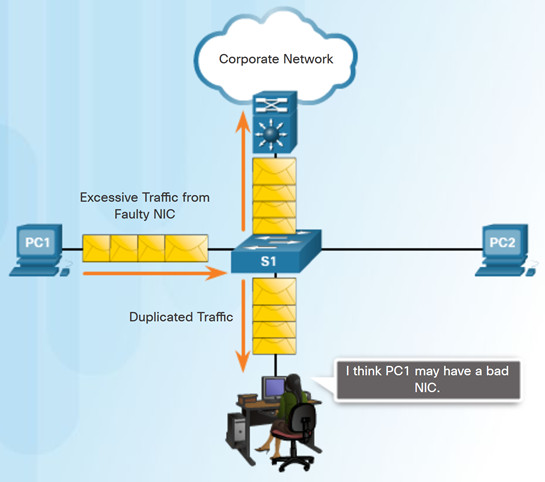
5.3.3.2 – Lab – Troubleshoot LAN Traffic Using SPAN
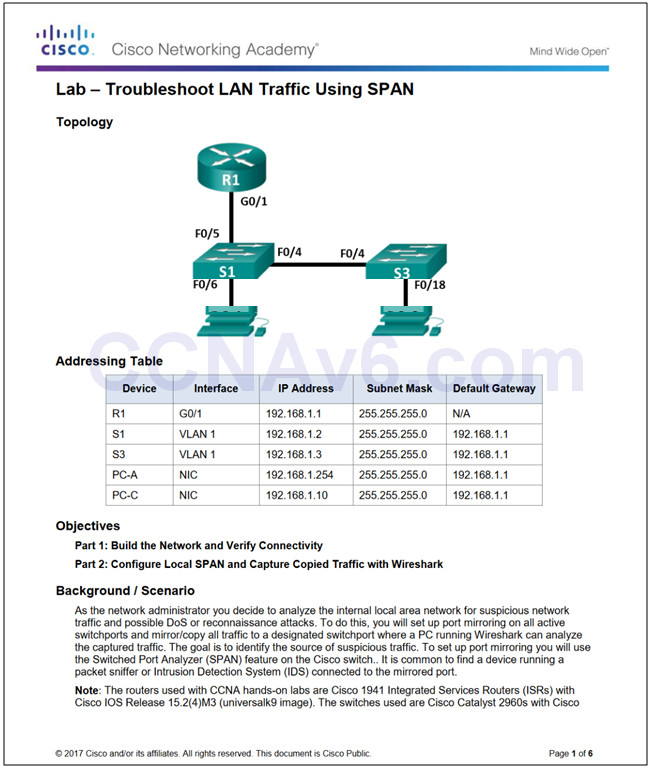
5.3.3.2 Lab – Troubleshoot LAN Traffic Using SPAN
5.4 – Summary
5.4.1 – Conclusion
5.4.1.1 – Chapter 5: Network Security and Monitoring
- Explain how to mitigate common LAN security attacks.
- Configure SNMP to monitor network operations in a small to medium-sized business network.
- Troubleshoot a network problem using SPAN.
New Terms and Commands
| •CDP reconnaissance attacks
•Telnet attacks •MAC address table flooding attacks •DHCP spoofing attacks •Authentication, Authorization, and Accounting (AAA) •IEEE 802.1X. •Simple Network Management Protocol (SNMP) •Intrusion Prevention System (IPS) •Switched Port Analyzer (SPAN) •Cisco Discovery Protocol (CDP) •Link Layer Discovery Protocol (LLDP) •Terminal Access Controller Access Control System (TACACS+) protocol •Remote Authentication Dial-In User Service (RADIUS) protocol |
•Dynamic Trunking Protocol (DTP)
•port security •DHCP starvation attack •denial-of-service (DoS) attack •DHCP snooping •Dynamic ARP inspection •IP Source Guard •DHCP Snooping Binding Database •Local AAA Authentication •Server-Based AAA Authentication •Supplicant •Authenticator •SNMP manager •SNMP agents |
| •Management Information Base (MIB)
•network management system (NMS) •SNMP traps •get request •set request •network baseline •community strings •object ID (OID) •snmpget •packet analyzer •port mirroring •Local SPAN •Remote SPAN (RSPAN) |
